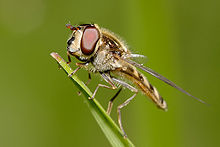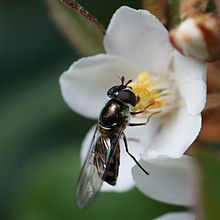- Melangyna viridiceps
-
Melangyna viridiceps 
Scientific classification Kingdom: Animalia Phylum: Arthropoda Class: Insecta Order: Diptera Family: Syrphidae Genus: Melangyna Species: M. viridiceps Binomial name Melangyna viridiceps
(Macquart, 1847) [1]Melangyna viridiceps is an Australasian hoverfly, known in Australia as the common hover fly.[2] It is found across Eastern Australia, as well as on the Kermadec Islands of New Zealand,[3] and is one of the two most common hoverflies in Australia, alongside Simosyrphus grandicornis,[4] but can be distinguished by its all black thorax.[5] The adult flies feed on pollen and nectar which they gather from flowers, while the larvae feed on aphids.[6]
References
- ^ Rudolf Meier et al. (17 May 2005). "Collection inventory of the Diptera collection: Syrphidae". Zoological Museum, University of Copenhagen (ZMUC). http://www.zmuc.dk/entoWeb/collections-databaser/Diptera/Syrphidae%20all.htm.
- ^ "Common hover fly Melangyna viridiceps". CSIRO. 18 September 2004. http://www.ento.csiro.au/aicn/name_c/a_980.htm.
- ^ R. P. Macfarlane, I. G. Andrew, B. J. Sinclair et al. (3 March 2000). "Checklist of New Zealand Diptera". New Zealand Entomological Society. http://www.ento.org.nz/diptera_checklist.htm.
- ^ E. Soleyman-Nezhadiyan & R. Laughlin (1998). "Voracity of larvae, rate of development in eggs, larvae and pupae, and flight seasons of adults of the hoverflies Melangyna viridiceps Macquart and Symosyrphus grandicornis Macquart (Diptera: Syrphidae)". Australian Journal of Entomology 37 (3): 243–248. doi:10.1111/j.1440-6055.1998.tb01578.x.
- ^ Chew, Peter. "Hover Fly - Family Syrphidae". http://www.brisbaneinsects.com/brisbane_flies/SYRPHIDAE.htm. Retrieved 2011-08-30.
- ^ "Common hover fly — Melangyna viridiceps". Brisbane Insects and Spiders Home Page. 22 December 2004. Archived from the original on 28 August 2005. http://web.archive.org/web/20050828111113/http://www.geocities.com/brisbane_flies/CommonHover.htm. (Note that while the text is correct, the photos are misidentified specimens of Simosyrphus)

This article related to members of the insect family Syrphidae is a stub. You can help Wikipedia by expanding it.

